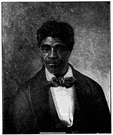|
|

The Life of Dred Scott
Dred Scott lived and died a slave, despite his best efforts to become a free man in the Supreme Court case that bears his name.
He was born in 1799, to the Peter Blow family, in Virginia. He grew up a slave and never learned to read or write. He was still enslaved to the Blow family when they all moved to St. Louis, in 1830. Soon after, Scott was sold to Dr. John Emerson, a military doctor. During the next dozen years, Emerson and Scott traveled to the Illinois and Wisconsin Territories, living for a time in both places. During this time, also, Scott married another slave, Harriet Robinson. (They would eventually have two children.)
The Emersons and the Scotts returned to St. Louis in 1842. A year later, Dr. Emerson died and his wife, Irene, sent the Scotts and their children to work for other families in St. Louis.
 Scott's political life began in 1846, when he filed a lawsuit against Irene Emerson for maltreatment. He was also seeking his freedom, on the theory that he had lived in Illinois and Wisconsin Territories, which prohibited slavery, and so he was a citizen of free territories and, therefore, free himself. During the next four years, Scott would first lose and then win his suit. Following the second case, Mrs. Emerson appealed to the Missouri Supreme Court, which favored Emerson. Scott's political life began in 1846, when he filed a lawsuit against Irene Emerson for maltreatment. He was also seeking his freedom, on the theory that he had lived in Illinois and Wisconsin Territories, which prohibited slavery, and so he was a citizen of free territories and, therefore, free himself. During the next four years, Scott would first lose and then win his suit. Following the second case, Mrs. Emerson appealed to the Missouri Supreme Court, which favored Emerson.
Scott turned in his own appeal, asking the U.S. Circuit Court to review his case. By this time, he had been sold again, this time to Mrs. Emerson's brother, John Sanford. The Circuit Court ruled in favor of Sanford, and Scott files one final appeal: to the U.S. Supreme Court.
In a political charged decision, the Court, under Chief Justice Roger Taney, rules that Scott was a slave forever and that he had no rights as a citizen and that the Missouri Compromise, which prohibited slavery in northern states and territories, was unconstitutional because of the Fifth Amendment prohibition of denial of property without due process of law. In other words, Scott was still the property of Sanford and had no further recourse in his quest to gain his freedom.
The decision angered a great many people in the North and emboldened a great many people in the South. It was one of the main causes of the Civil War, in the opinion of many historians.
His options exhausted, Scott remained a slave, the property of Irene Emerson. In the same year that the decision was announced, Emerson sold Scott and his family back to his original owners, the Blow family, who promptly gave them all their freedom.
Now that he was free, Dred Scott seemingly had the world at his feet. Sadly, though, he died of tuberculosis a short year later. He was buried in St. Louis.
|
|